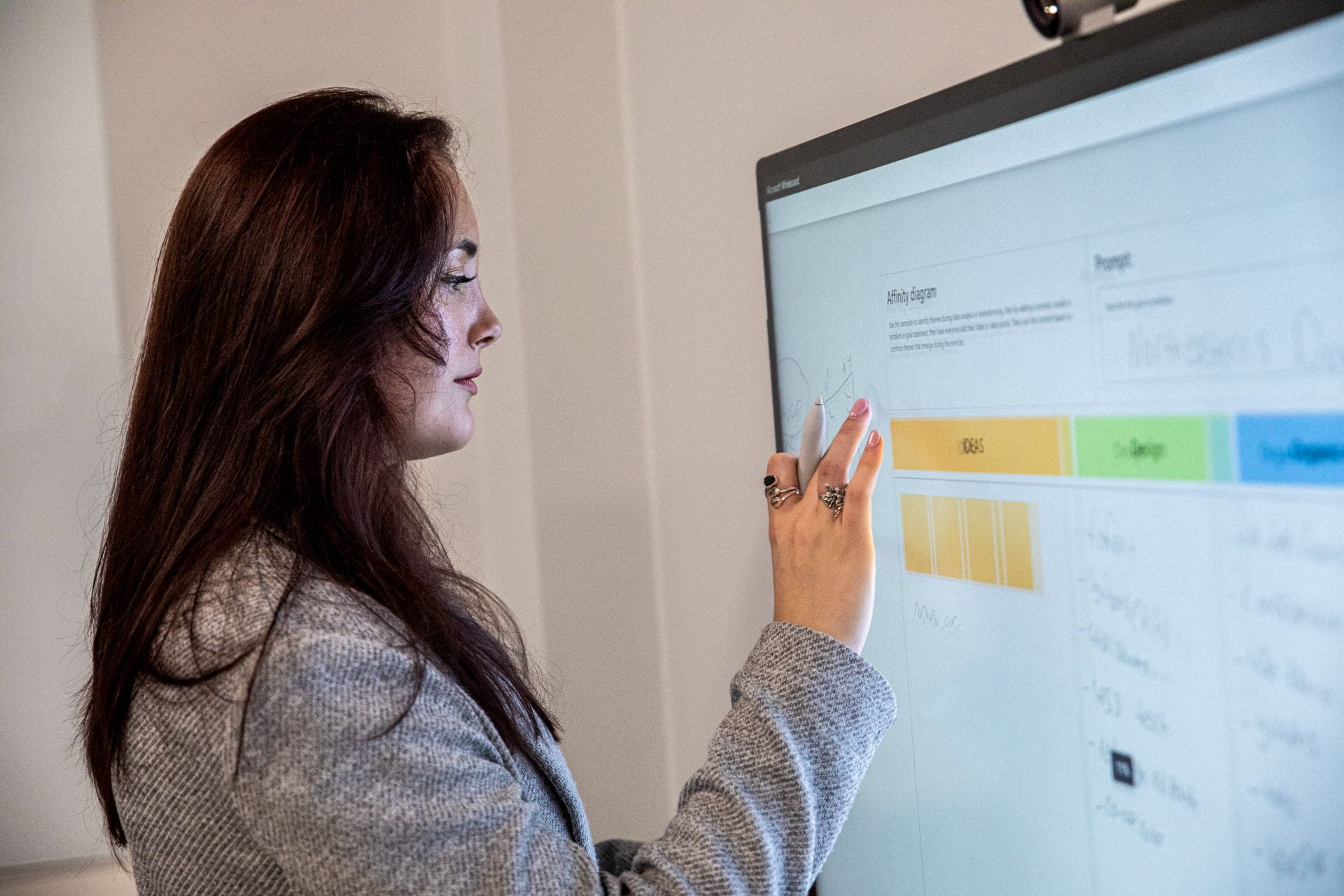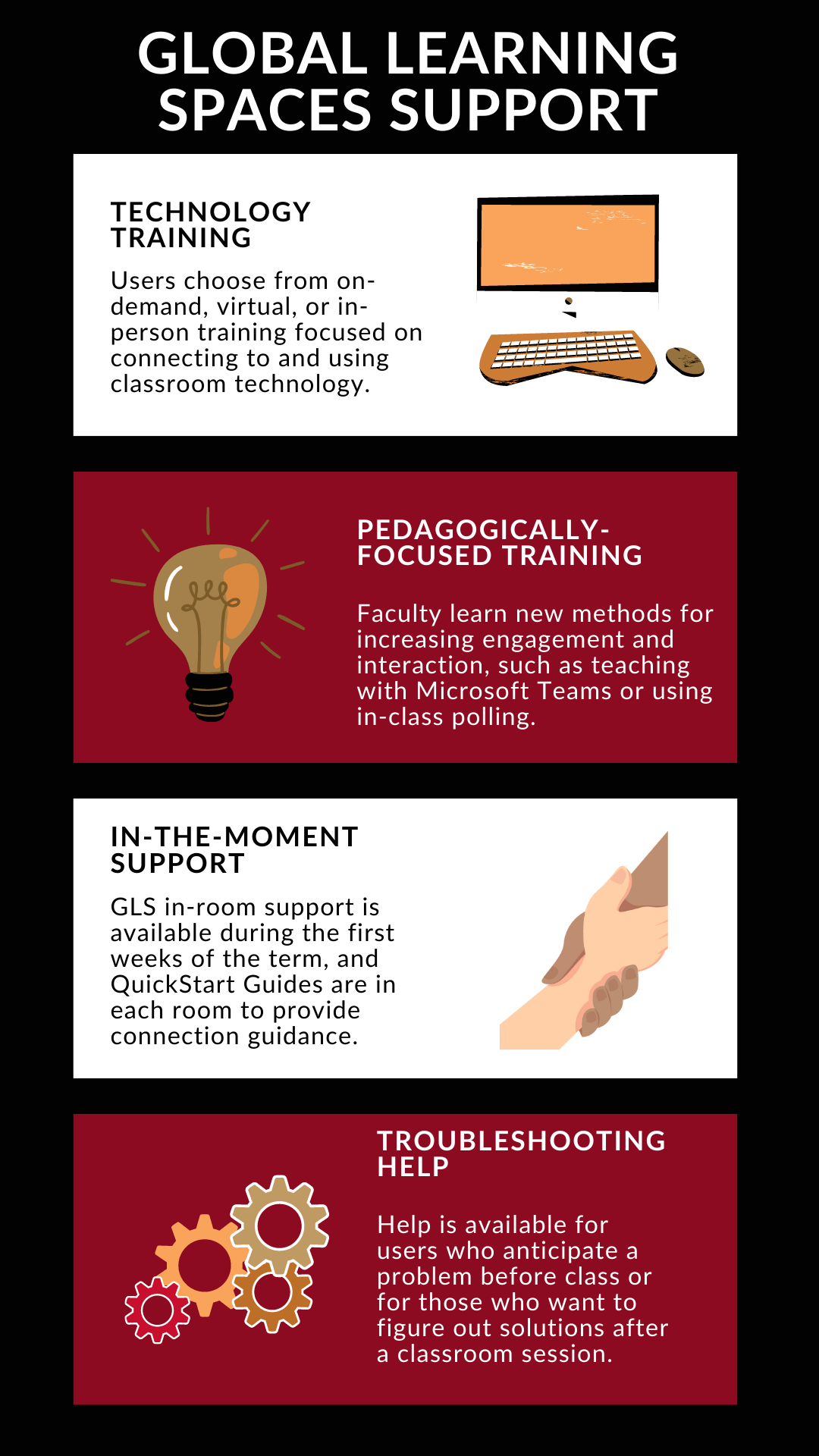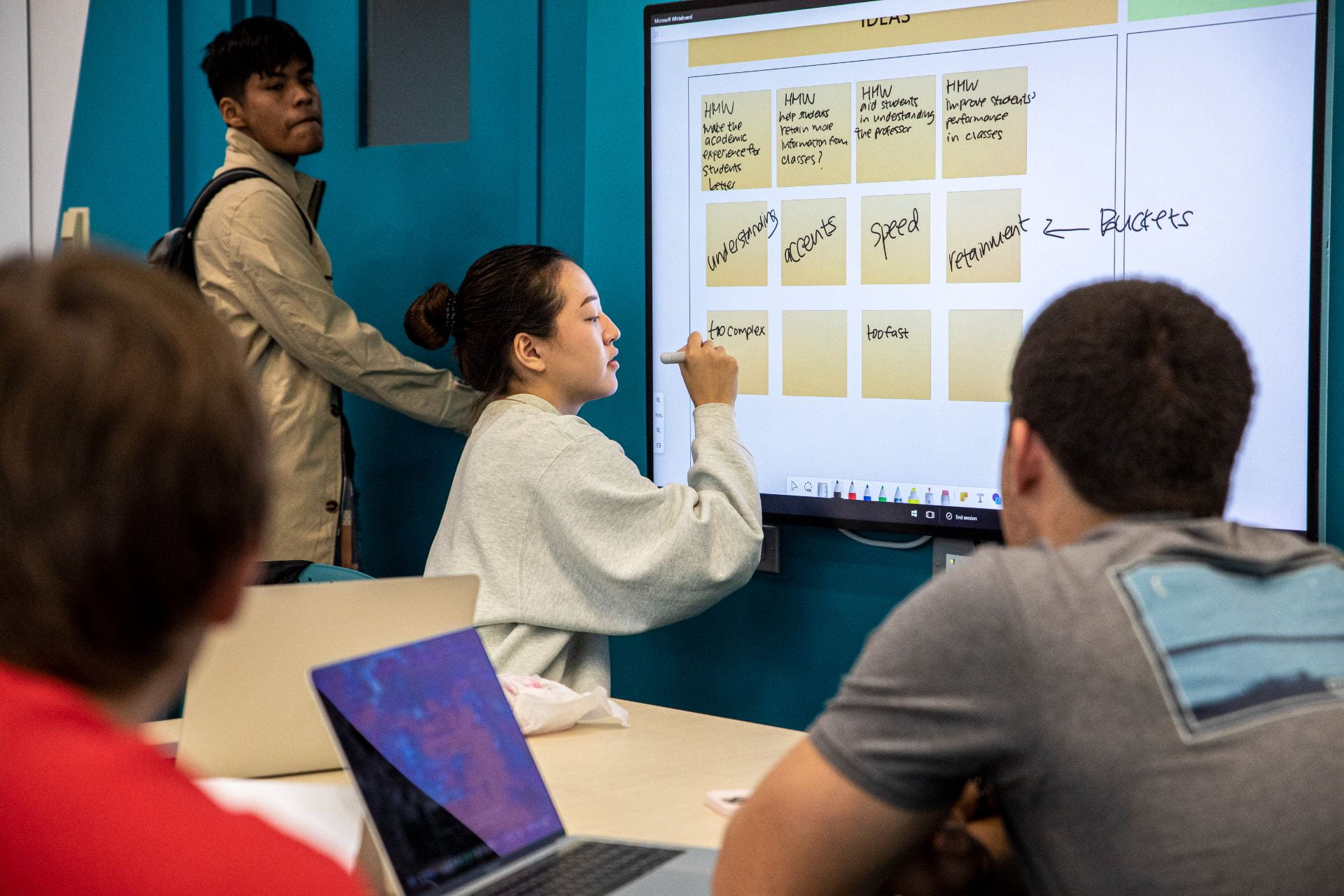In an ideal world, technology would be quick to set up, easy to use, and effective at accomplishing the user’s purpose. At Northeastern, Global Learning Spaces are providing this kind of technological experience for both students and faculty.
The initiative to create Global Learning Spaces—classrooms that offer top-tier equipment and ease of use—is a creation of ITS, the Office of the Provost, Facilities, and several other campus teams. The initiative supports Northeastern’s commitment to experiential, global learning by creating classrooms where technology fully supports collaboration and where student engagement is, most importantly, easy to create.

Global Learning Spaces allow students from all of Northeastern’s campuses—whether in Oakland, Boston, Vancouver, or another global site—to gather simultaneously, share screens with ease, and collaborate in the learning process. Because instructors bring their own devices (laptops, tablets, or phones) to connect to the classroom technology, there is no need to learn how to use a different computer. With one click, instructors easily connect their devices and share content. Eventually, all classrooms will be powered by the instructor’s device, as classroom computers are retired.
Northeastern professor uses technology to increase engagement
NOTE: The TTT program referenced here is no longer active, but Academic Technologies offers training and personal consultations for instructors wishing to use tablets for teaching.
Before the start of the 2021-22 academic year, Kris Jaeger-Helton, teaching professor and director of Senior Capstone Design for the Industrial Engineering program in the College of Engineering, was seeking new opportunities to infuse more engagement and technical clarity into her engineering courses. Driven by her desire to continuously improve and effectively adapt to changes in the classroom—especially those in response to restrictions imposed by the COVID-19 pandemic—Jaeger-Helton explored the use of tablets in her teaching.
Excited by the fall 2021 announcement of the Transforming Teaching with Tablets (TTT) program, Jaeger-Helton applied for a spot in the pilot. Although she had never used a tablet … READ MORE
The creation of Global Learning Spaces began in the spring term of 2022, and by the end of that summer, there were 51 GLS classrooms. This summer, ITS has converted even more classrooms to these state-of-the-art global, digital spaces, bringing the number of GLS classrooms to over 100, and counting. Karen McCarthy, Associate VP, Information Technology Services Operations and Deputy CIO, explains: “We’ve been able to create 60-70 new spaces over the 2022-2023 holiday break and the last few summer months. The supply chain has greatly improved, and that has enabled us to get the equipment we need.” McCarthy says that ITS has received over 500 requests for classroom upgrades and collaboration spaces. Clearly, the initiative to create more Global Learning Spaces has gained momentum.
Creating consistency
All Global Learning Spaces have roughly the same equipment, enabling instructors to have a consistent set-up and operation experience. These classrooms are equipped with a simple control panel that allows instructors to connect their laptops, tablets, or phones and share content. GLS classrooms also have microphones, displays, and cameras. Once an instructor has learned to operate the equipment, there’s no learning curve when using a different Global Learning Space. A Global Learning Space in Seattle is as easy to use as one in Vancouver.
Students also benefit from consistency. Global Learning Spaces are optimized for Microsoft Teams integration, so as more instructors use Teams for classroom collaboration, the student experience becomes more consistent. Knowing what to expect from the technology helps students focus less on technical issues and more on participating and learning.
Creating collaboration, increasing engagement
Methods for collaborating—such as using videoconferencing, having students work in groups, or creating synchronous learning sessions for on-campus and remote students—can be challenging in older classrooms where screen sizes and locations may not be optimized for remote communications. In Global Learning Spaces, no student has a “bad seat.” These spaces are built for remote collaboration, so all technology—microphones, screens, digital whiteboards—are easily viewable and accessible for all students.
In an evaluation of the tools supported by Global Learning Spaces classrooms, students confirmed that the tools increased engagement and collaboration.
One student wrote, “Having remote access technologies integrated into the classroom learning experience improves my learning as I can connect with peers/teams remotely (when one or more are absent) to solve classroom-based exercises, work on group assignments, pick up shared resources, ask questions and receive replies in real-time.”
The same survey showed that 88% of students strongly or somewhat agreed with the statement, “The classroom technology supported my ability to access materials in a way that made sense to me.”
When the classroom is also treated as a digital team, students can share and annotate content, create chats during class that persist after class and serve as study notes, work in breakout rooms, and collaborate in a host of other ways. Lindsey Sudbury, Director of Academic Technologies, explains: “Microsoft Teams is a great option for instructors looking for opportunities to incorporate the classroom into a larger student engagement strategy. It provides a bridge between the in-person and online space that allows for collaboration during and between class sessions.” GLS classrooms were created with Microsoft Teams in mind, so the technology is designed to work seamlessly with the tools in Teams.

Creating new teaching modalities
Technology is only effective if people want to use it. Since the creation of GLS classrooms in 2022, Academic Technologies and Digital University Solutions teams have created training and support options to meet the needs of faculty and administrative users.
Two kinds of training are offered. Technology training focuses on using the classroom equipment in Global Learning Spaces. Faculty can choose from several training modalities, including hybrid, in-person, and virtual training sessions. In addition, a wide array of on-demand, interactive training resources are available to further support instructors. “Instructors may feel apprehensive walking into a Global Learning Spaces classroom for the first time. Once instructors have attended our training, they are confident and prepared to leverage everything our classroom spaces have to offer,” explains Caryl Walling, Digital Solutions Training Lead.
Instructors who want to use Global Learning Spaces technology and Teams integration to try out new methods of teaching and learning can sign up for training from Academic Technologies. Training focuses on how to use the technology to accomplish pedagogical goals, such as having students create collaborative digital portfolios, make comments or annotations in real time during class, or participate in polls to gauge understanding before moving on to discuss another concept. Drew Ochengco, Academic Instructional Technologist and part-time lecturer notes, “Often times A/V in a room is just seen as a means to an end for classroom display, but the university as a whole is hoping to shift that thinking so that the room in itself is seen as a tool for person-to-person connection.”
Creating the future
The demand for top-tier classroom technology continues to drive the Global Learning Spaces initiative. Each semester, an additional set of classrooms will be converted to Global Learning Spaces. Because these classrooms provide functionality similar to modern conference rooms in tech-savvy businesses, students benefit from classroom experiences that are transferable and experiential. As such, Northeastern can expect to see growing interest—from both faculty and students—in using these classrooms for innovative and collaborative learning.
